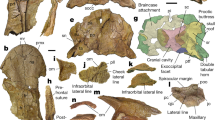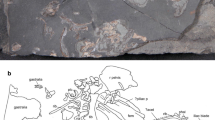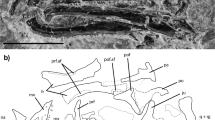Abstract
Phylogenetic analysis of early tetrapod evolution has resulted in a consensus across diverse data sets1,2,3 in which the tetrapod stem group is a relatively homogenous collection of medium- to large-sized animals showing a progressive loss of ‘fish’ characters as they become increasingly terrestrial4,5, whereas the crown group demonstrates marked morphological diversity and disparity6. The oldest fossil attributed to the tetrapod crown group is the highly specialized aïstopod Lethiscus stocki7,8, which shows a small size, extreme axial elongation, loss of limbs, spool-shaped vertebral centra, and a skull with reduced centres of ossification, in common with an otherwise disparate group of small animals known as lepospondyls. Here we use micro-computed tomography of the only known specimen of Lethiscus to provide new information that strongly challenges this consensus. Digital dissection reveals extremely primitive cranial morphology, including a spiracular notch, a large remnant of the notochord within the braincase, an open ventral cranial fissure, an anteriorly restricted parasphenoid element, and Meckelian ossifications. The braincase is elongate and lies atop a dorsally projecting septum of the parasphenoid bone, similar to stem tetrapods such as embolomeres. This morphology is consistent in a second aïstopod, Coloraderpeton, although the details differ. Phylogenetic analysis, including critical new braincase data, places aïstopods deep on the tetrapod stem, whereas another major lepospondyl lineage is displaced into the amniotes. These results show that stem group tetrapods were much more diverse in their body plans than previously thought. Our study requires a change in commonly used calibration dates for molecular analyses, and emphasizes the importance of character sampling for early tetrapod evolutionary relationships.
This is a preview of subscription content, access via your institution
Access options
Access Nature and 54 other Nature Portfolio journals
Get Nature+, our best-value online-access subscription
$29.99 / 30 days
cancel any time
Subscribe to this journal
Receive 51 print issues and online access
$199.00 per year
only $3.90 per issue
Buy this article
- Purchase on Springer Link
- Instant access to full article PDF
Prices may be subject to local taxes which are calculated during checkout



Similar content being viewed by others
Change history
14 August 2017
The Reviewer Information section was corrected.
References
Anderson, J. S., Reisz, R. R., Scott, D., Fröbisch, N. B. & Sumida, S. S. A stem batrachian from the Early Permian of Texas and the origin of frogs and salamanders. Nature 453, 515–518 (2008)
Vallin, G. & Laurin, M. Cranial morphology and affinities of Microbrachis, and a reappraisal of the phylogeny and lifestyle of the first amphibians. J. Vertebr. Paleontol. 24, 56–72 (2004)
Ruta, M. & Coates, M. I. Dates, nodes, and character conflict: addressing the lissamphibian origin problem. J. Syst. Palaeontol. 5, 69–122 (2007)
Coates, M. I. The Devonian tetrapod Acanthostega gunnari Jarvik: postcranial anatomy, basal tetrapod relationships and patterns of skeletal evolution. Trans. R. Soc. Edinb. Earth Sci. 87, 363–421 (1996)
Clack, J. A. An early tetrapod from ‘Romer’s Gap’. Nature 418, 72–76 (2002)
Anderson, P. S. L., Friedman, M. & Ruta, M. Late to the table: diversification of tetrapod mandibular biomechanics lagged behind the evolution of terrestriality. Integr. Comp. Biol. 53, 197–208 (2013)
Wellstead, C. F. A Lower Carboniferous aïstopod amphibian from Scotland. Palaeontology 25, 193–208 (1982)
Anderson, J. S., Carroll, R. L. & Rowe, T. B. New information on Lethiscus stocki (Tetrapoda: Lepospondyli: Aistopoda) from high-resolution computed tomography and a phylogenetic analysis of Aistopoda. Can. J. Earth Sci. 40, 1071–1083 (2003)
Anderson, J. S. Revision of the aïstopod genus Phlegethontia (Tetrapoda, Lepospondyli). J. Paleontol. 76, 1029–1046 (2002)
Carroll, R. L. Cranial anatomy of ophiderpetontid aïstopods: Palaeozoic limbless amphibians. Zool. J. Linn. Soc. 122, 143–166 (1998)
Anderson, J. S. Cranial anatomy of Coloraderpeton brilli, postcranial anatomy of Oestocephalus amphiuminus, and a reconsideration of Ophiderpetontidae (Tetrapoda: Lepospondyli: Aistopoda). J. Vertebr. Paleontol. 23, 532–543 (2003)
Smithson, T. R. The morphology and relationships of the Carboniferous amphibian Eoherpeton watsoni Panchen. Zool. J. Linn. Soc. 85, 317–410 (1985)
Holmes, R. The Carboniferous amphibian Proterogyrinus scheelei Romer, and the early evolution of tetrapods. Phil. Trans. R. Soc. Lond. B 306, 431–524 (1984)
Porro, L. B., Rayfield, E. J. & Clack, J. A. Descriptive anatomy and three-dimensional reconstruction of the skull of the early tetrapod Acanthostega gunnari Jarvik, 1952. PLoS One 10, e0118882 (2015)
Clack, J. A. et al. A uniquely specialized ear in a very early tetrapod. Nature 425, 65–69 (2003)
Ahlberg, P. E. & Clack, J. A. Lower jaws, lower tetrapods – a review based on the Devonian genus Acanthostega. Trans. R. Soc. Edinb. Earth Sci. 89, 11–46 (1998)
Dawson, J. W. Air-Breathers of the Coal Period: a Descriptive Account on the remains of Land Animals found in the Coal Formation of Nova Scotia, with Remarks on their Bearing on Theories of the Formation of Coal and of the Origin of Species (Dawson Brothers, 1863)
Vaughn, P. P. The Paleozoic microsaurs as close relatives of reptiles, again. Am. Midl. Nat. 67, 79–84 (1962)
Carroll, R. L. & Baird, D. The Carboniferous amphibian Tuditanus (Eosauravus) and the distinction between microsaurs and reptiles Am. Mus. Novit. 2337, 1–50 (1968)
Panchen, A. L. On the amphibian Crassigyrinus scoticus Watson from the Carboniferous of Scotland. Phil. Trans. R. Soc. Lond. B 309, 505–568 (1985)
Beaumont, E. H. & Smithson, T. R. The cranial morphology and relationships of the aberrant Carboniferous amphibian Spathicephalus mirus Watson. Zool. J. Linn. Soc. 122, 187–209 (1998)
Pardo, J. D. & Anderson, J. S. Cranial morphology of the Carboniferous-Permian tetrapod Brachydectes newberryi (Lepospondyli, Lysorophia): new data from μCT. PLoS One 11, e0161823 (2016)
Maddin, H. C., Olori, J. C. & Anderson, J. S. A redescription of Carrolla craddocki (Lepospondyli: Brachystelechidae) based on high-resolution CT, and the impacts of miniaturization and fossoriality on morphology. J. Morphol. 272, 722–743 (2011)
Reisz, R. R. A diapsid reptile from the Pennsylvanian of Kansas. Univ. Kansas Museum of Natural History Special Publications 7, 1–74 (1981)
Milner, A. R. & Sequeira, S. E. K. The temnospondyl amphibians from the Viséan of East Kirkton, West Lothian, Scotland. Trans. R. Soc. Edinb. Earth Sci. 84, 331–361 (1994)
Smithson, T. R., Carroll, R. L., Panchen, A. L. & Andrews, S. M. Westlothiana lizziae from the Viséan of East Kirkton, West Lothian, Scotland, and the amniote stem. Trans. R. Soc. Edinb. Earth Sci. 84, 383–412 (1994)
Benton, M. J., Donoghue, P. C. J., Asher, R. J., Friedman, M., Near, T. J. & Vinter, J. Constraints on the timescale of animal evolutionary history. Palaeontol. Electron. 18.1.1FC (2015)
Huttenlocker, A. K., Pardo, J. D., Small, B. J. & Anderson, J. S. Cranial morphology of recumbirostrans (Lepospondyli) from the Permian of Kansas and Nebraska, and early morphological evolution inferred by micro-computed tomography. J. Vertebr. Paleontol. 33, 540–552 (2013)
Maddin, H. C. & Anderson, J. S. Evolution of the amphibian ear with implications for lissamphibian phylogeny: insight gained from the caecilian inner ear. Fieldiana Life Earth Sci. 5, 59–76 (2012)
Clack, J. A., Ahlberg, P. E., Blom, H. & Finney, S. M. A new genus of Devonian tetrapod from North-East Greenland, with new information on the lower jaw of Ichthyostega. Palaeontology 55, 73–86 (2012)
Acknowledgements
We thank S. Pierce, J. Cundiff, the late F. A. Jenkins, C. Schaff, the late W. Amaral, D. Berman, A. Henrici, P. Holroyd, A. C. Milner, J. A. Clack, J. Bolt and W. Simpson for access to specimens, and J. Bolt, R. Carroll, J. A. Clack, M. Coates, N. Fröbisch, D. Germain, A. Huttenlocker, M. Laurin, H. Maddin, D. Marjanović, J. Olori, R. R. Reisz, and R. Schoch for discussions. We particularly thank D. Germain for first suggesting reanalysis of the Lethiscus data set with current computational tools. This research was supported in part by a Natural Sciences and Engineering Research Council of Canada Discovery Grant to J.S.A.
Author information
Authors and Affiliations
Contributions
Project instigated by J.S.A. and J.D.P. Micro-CT volumetric data compiled by J.D.P., M.S., P.E.A. and J.S.A. Phylogenetic analysis by J.D.P., M.S., P.E.A. and J.S.A. Paper written by J.S.A., J.D.P., M.S. and P.E.A.
Corresponding author
Ethics declarations
Competing interests
The authors declare no competing financial interests.
Additional information
Reviewer Information Nature thanks D. Marjanović and S. Sumida for their contribution to the peer review of this work.
Publisher's note: Springer Nature remains neutral with regard to jurisdictional claims in published maps and institutional affiliations.
Extended data figures and tables
Extended Data Figure 1 Skull and lower jaw of L. stocki, MCZ 2185, and lower jaw of C. brilli, CM 47687.
a–j, Skull shown in dorsal (a, b), right lateral (c, d), ventral (e, f), anterior (g, i), and occipital (h, j) views. k–n, Lower jaws shown in medial (k, l) and lateral (m, n) views. All are to scale. inf, internarial fontanelle; mllc, mandibular lateral line canal; pp, postparietal; qrpt, quadrate ramus of pterygoid.
Extended Data Figure 2 Skull of L. stocki, MCZ 2185, main block.
a–d, Specimen figured in dorsal (a), right lateral (b), ventral (c), and left lateral (d) views. All are to scale.
Extended Data Figure 3 Skull of L. stocki, MCZ 2185.
a, Skull roof. b, c, Snout. All are to scale.
Extended Data Figure 4 Skull of C. brilli, CM 47687.
a–c, Specimen figured in dorsal (a), lateral (b), and ventral (c) views. All are to scale. pof, postfrontal; prat, proatlas; ?preop, possible preopercular.
Extended Data Figure 5 Braincase of C. brilli, CM 47687.
a–d, Specimens figured in left lateral (a), dorsal (b), ventral (c), and right lateral (d) views. All are to scale. fme, foramen metoticum; fv, fenestra vestibularis; pit, foramen serving pituitary artery; sphen, sphenethmoid.
Extended Data Figure 6 Lower jaws of L. stocki, MCZ 2185 and C. brilli, CM 47687.
CT volumes on left, line drawings on right. a–h, Left lower jaw of Lethiscus shown in dorsal (a, b), medial (c, d), lateral (e, f), and ventral (g, h) views. i–p, Left lower jaw of C. brilli shown in dorsal (i, j), medial (k, l), lateral (m, n), and ventral (o, p) views. Not to scale. c, coronoid; c1, first coronoid; cf, coronoid foramen; mf, Meckelian foramen.
Extended Data Figure 7 Phylogenetic analysis showing relationships of the aïstopods L. stocki and C. brilli, and selected lepospondyls.
Consensus (a) and bootstrap (b) trees, showing relationships of 58 tetrapod and tetrapodomorph taxa. a, Consensus tree represents majority rule consensus of 36 most parsimonious trees (1,684 steps). Node values indicate per cent frequency for this topology appearing among the most parsimonious trees. b, Bootstrap tree shows majority rule consensus of trees produced via 1,000 bootstrap replicates resampled with replacement. Node values indicate bootstrap support.
Supplementary information
Supplementary Information
This file contains Supplementary details regarding the matrix construction and coding changes, the phylogenetic character list, nexus scripts and Supplementary References. (PDF 1331 kb)
Video 1: 3D yaw of main skull block of Lethiscus stocki (MCZ 2185)
3D yaw of main skull block of Lethiscus stocki (MCZ 2185). Scale is in millimeters. (MP4 6561 kb)
Video 2: 3D pitch of main skull block of Lethiscus stocki (MCZ 2185)
3D pitch of main skull block of Lethiscus stocki (MCZ 2185). Scale is in millimeters. (MP4 9449 kb)
Video 3: 3D yaw of braincase of Lethiscus stocki (MCZ 2185)
3D yaw of braincase of Lethiscus stocki (MCZ 2185). Scale is in millimeters. (MP4 2592 kb)
Video 4: 3D yaw of cranial endocast of Lethiscus stocki (MCZ 2185)
3D yaw of cranial endocast of Lethiscus stocki (MCZ 2185). Scale is in millimeters. (MP4 1736 kb)
Video 5: 3D yaw of skull of Coloraderpeton brilli (CM 47687)
3D yaw of skull of Coloraderpeton brilli (CM 47687). Scale is in microns. (MP4 4718 kb)
Video 6: 3D roll of braincase of Coloraderpeton brilli (CM 47687)
3D roll of braincase of Coloraderpeton brilli (CM 47687). Scale is in microns. (MP4 10881 kb)
Rights and permissions
About this article
Cite this article
Pardo, J., Szostakiwskyj, M., Ahlberg, P. et al. Hidden morphological diversity among early tetrapods. Nature 546, 642–645 (2017). https://doi.org/10.1038/nature22966
Received:
Accepted:
Published:
Issue Date:
DOI: https://doi.org/10.1038/nature22966
This article is cited by
-
A new Carboniferous edaphosaurid and the origin of herbivory in mammal forerunners
Scientific Reports (2023)
-
Triassic stem caecilian supports dissorophoid origin of living amphibians
Nature (2023)
-
Snake-like limb loss in a Carboniferous amniote
Nature Ecology & Evolution (2022)
-
A Mississippian (early Carboniferous) tetrapod showing early diversification of the hindlimbs
Communications Biology (2022)
-
Fossil bone histology reveals ancient origins for rapid juvenile growth in tetrapods
Communications Biology (2022)
Comments
By submitting a comment you agree to abide by our Terms and Community Guidelines. If you find something abusive or that does not comply with our terms or guidelines please flag it as inappropriate.



